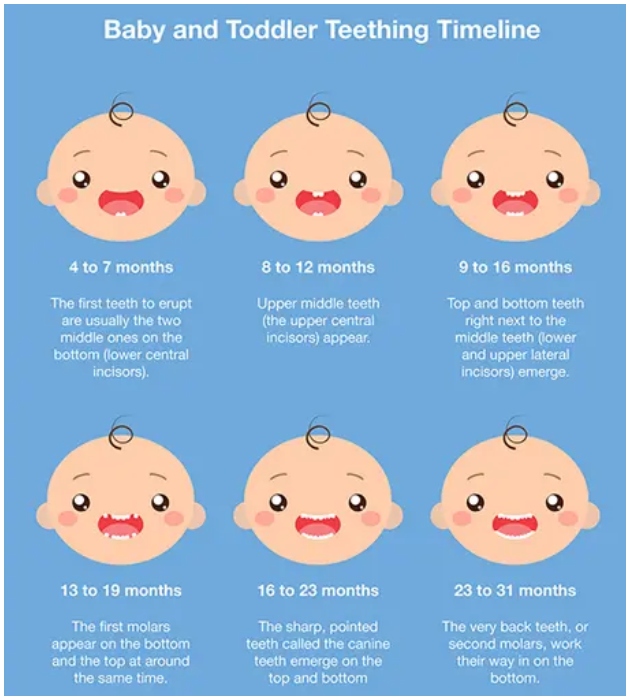The arrival of your baby’s first tooth is a landmark event in their development, signifying the transition from infancy towards toddlerhood. However, the process of teething is often accompanied by discomfort for your baby, leading to restless days and sleepless nights for the entire family. Understanding the nuances of this developmental phase and employing effective soothing strategies can help mitigate the challenges of teething, ensuring a smoother experience for both you and your little one.
Identifying Teething Signs
Teething generally begins around the 6-month mark, though it varies widely among infants. The symptoms can often be confused with other health issues, making it vital for parents to recognize them accurately:
- Swollen, tender gums
- Increased drooling, leading to drool rash
- A marked increase in chewing behavior
- Irritability or fussiness
- A slight elevation in temperature, typically around 99°F
It’s crucial to understand that while teething can cause discomfort, it shouldn’t result in high fevers or diarrhea. If your baby exhibits such symptoms, it’s imperative to consult a healthcare professional promptly.

Effective Teething Relief Strategies
- Gentle Gum Massage: A soft, pressure-applying massage can significantly relieve your baby’s discomfort. Ensure your hands are clean and gently rub your baby’s gums, providing both relief and potentially aiding in sleep.
- The Cold Washcloth Method: A damp, chilled washcloth can offer soothing relief when chewed on. Ensure it’s clean and supervised usage to prevent any choking hazards.
- Chilled Pacifiers and Teething Toys: Cooling these items in the refrigerator (never the freezer, as extreme cold can harm your baby’s gums) can provide a soothing effect. Opt for solid teething toys, as liquid or gel-filled ones might pose a leakage risk.
- Nutritious Popsicles: Creating popsicles from breastmilk or formula in BPA-free molds can be a dual-purpose solution, offering relief and sustaining nutrition, especially when your baby is averse to feeding due to gum pain.
- Drool Management: Keeping a bib on your baby and regularly wiping their face can prevent rashes associated with excessive drooling. Maintaining dry skin is essential for comfort.
- Cool Fruits for Gum Relief: For babies introduced to solids, offering chilled fruits like mashed bananas or pieces within a mesh feeder can soothe sore gums while ensuring safety against choking under strict supervision.
- Extra Comforting Measures: Physical closeness, whether through cuddling, rocking, or carrying in a baby carrier, can significantly alleviate your baby’s distress, providing comfort and security during this uncomfortable phase.
- Consultation for Medicinal Relief: In cases of severe discomfort, consulting your pediatrician for appropriate over-the-counter pain relief can be considered. Ensure any medication is safe and suitable for your baby’s age.
Teething Timeline Variability
The teething process differs widely among infants; for some, it’s a drawn-out experience, while for others, teeth may appear with minimal fuss. Typically, the pain subsides once the tooth cuts through the gum, with periods of relief between emerging teeth.
Establishing Early Dental Care
With the emergence of your baby’s first teeth, initiating dental hygiene practices is crucial. Gently cleaning the teeth with a damp cloth or a soft-bristled brush lays the foundation for healthy oral habits. Fluoride toothpaste should be avoided until your child can reliably spit it out, usually by age 3. Using a small amount of training toothpaste can help familiarize your baby with the brushing process without the risks associated with fluoride ingestion.

The Importance of Pediatric Dental Visits
Scheduling your baby’s first dental check-up soon after the first tooth appears is essential for monitoring their oral health and ensuring proper dental development. Regular dental visits help in identifying any potential issues early on and reinforce the importance of oral hygiene from a young age.
Conclusion: Embracing the Teething Phase with Confidence
Teething is an inevitable part of your baby’s growth journey, marked by moments of discomfort and distress. However, with the right knowledge and strategies at your disposal, you can effectively soothe your baby’s teething pains, making this developmental milestone more manageable for both of you. Remember, every baby experiences teething differently, and what works for one may not work for another. Through patience, trial and error, and a lot of tender loving care, you can help your baby navigate the teething process with minimal discomfort, laying the groundwork for a healthy, happy smile for years to come.